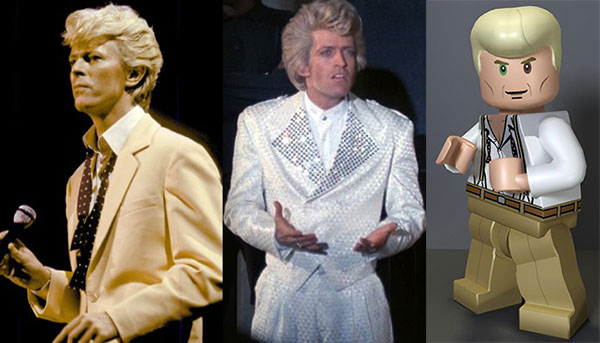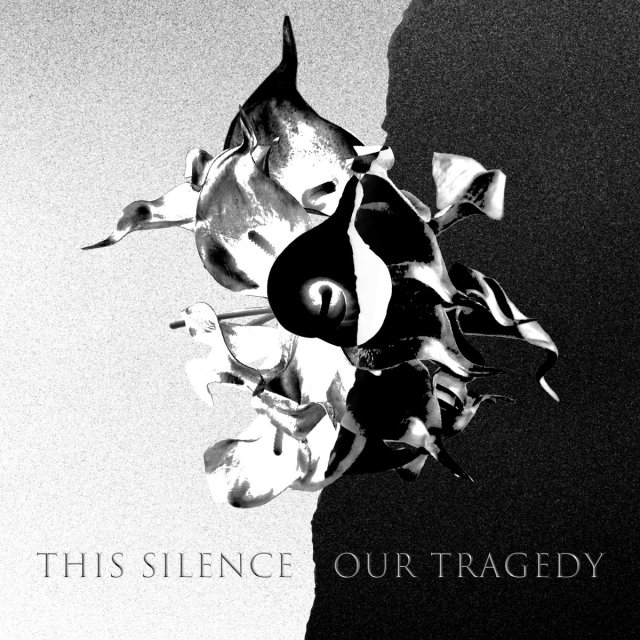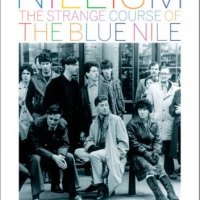What was it about the mid-80s that made it the harbinger of artistic disaster for so many artists that I had previously thought the world of? By 1985, there seemed to be a perfect storm of political and social currents conspiring to hammer all of the square pegs that didn’t quite fit into round holes come hell or high water. Of course, those square pegs were beloved by me for exactly the reason that they did not fit into the prevailing molds that were never of interest to me from the very beginning. Nevertheless, even artists as great as meta-influence David Bowie succumbed to this wave, though tellingly, he managed to stumble first, in 1983. As usual, Bowie was always ahead of the pack.
Until March of 1983, David Bowie could do no wrong. Sure, he released the odd track like “Under Pressure” that was far from being prime Bowie, but that seemed like a lark done on the spur of the moment. By 1981 following the masterful “Scary Monsters” album, Bowie had become a genre unto himself as scads of New Romantics all pounced on various fragments of his past artistic personae and elaborated on them to power dozens of careers. Aping Bowie was good business for nearly a decade, but in particular, his “Berlin Trilogy” served as artistic grist for much of the best that Post-Punk had to offer. So it was until that fateful night in March when MTV premiered his new video, “Let’s Dance.”
If you are old enough, you may remember that MTV was one of the first cable channels to simulcast in stereo. If you split your cable input and ran the lead into the antenna terminals on your stereo, you could tune the FM dial until you were receiving MTV in [poor quality, on my cable system] stereo. In preparation for “Let’s Dance,” I made sure that a cassette was recording in my deck so I could listen to the song until the actual record was in stores to buy. At the fateful hour, amid the pomp and circumstance of a World Premiere Video®, the clip ran as did my VCR and cassette tape, only the next day I really didn’t want to hear it again.
What greeted my ears was inconceivably mainstream pablum of a low order indeed. The record sounded stupid, something that I couldn’t have said about any Bowie releases I’d heard before, not even “The Laughing Gnome.” At least that record had a sense playful sense of fun that buoyed it happily along as it overdosed on gnome puns that even managed to reference Mick Jagger’s education! This single, in comparison, sounded not only lobotomized, but actually evil. It proffered fascist disco; as if Leni Riefenstahl had made a 12″ single instead of a film. The heraldic horn figure that acts as the tune’s hook was relentless and charmless. The arrangement sounded like tanks crushing bones underneath as their inexorable lurch forward could not be stopped.
The next day at college my friends all discussed our disappointment and wondered how Bowie could have made this record. The wait since “Scary Monsters” had been three long years; an eternity in pop [at the time]. Bowie clones had come and gone during that time and he remained the eminence gris behind several pop trends and movements that had moved forward in his absence. This record was not the challenging art rock that we had expected by then. Not by a long shot.
What we could not have known at the time was that there had been very practical reasons for Bowie’s three years of inactivity as well as his naked grab for cash with “Let’s Dance.” His exploitative contract with Mainman Management had been overturned and his sitting out the years of ’81-’82 were for practical reasons. He was free to earn much more than he ever had before on any new recordings released after his agreement with Mainman had ended on the terms specified. Bowie had been bled dry by Tony Defries and by 1983, was free to earn some real money.
So Bowie felt the need to really make some cash. He blew off Tony Visconti for Nile Rodgers; causing a nearly 20 year rift between himself and his longtime producer. Nile Rodgers, for his part, was expecting to make an intriguing, artistic David Bowie album, only to discover that he was being hired to facilitate hits. So hits were delivered. As lead guitarist, Bowie hired Stevie Ray Vaughan, who was on the cusp of stardom himself by that time, but the Texas blues rocker was a poor fit with the remorseless “dance” music being crafted in The Power Station studios. As much as Vaughan’s own music is a good time, that can’t be said of the resulting Bowie sessions.
When the second and third singles were peeled off of the “Let’s Dance” album like hundred dollar bills off a pimp’s roll of filthy lucre, they only served to elaborate the story that we’d lost David Bowie. Thus began a five year [?] period of attempting to ignore the painful releases by an artist who once could command our attention effortlessly. That time felt like a scar upon me. It was an inconceivable notion that had become a horrifying reality. Not so much a reality as a living nightmare. The fact is, that I never even heard the full “Let’s Dance” album until 1999; over sixteen years following its release.
The worst thing about the “Let’s Dance” album, is that the singles were by far the best that it had to offer! The rest of the material was either completely unmemorable filler [“Without You,” “Ricochet,” “Shake It”] or vastly inferior covers of tunes done better the first time [Bowie’s own “Cat People” and Metro’s “Criminal World”]. And yet, it sold over ten million copies. It fattened Bowie’s coffers, and in the only good karma the record engendered, kept “Criminal World” writer Peter Godwin in clover that was richly deserved, but at what cost?
The karmic blade twisted exceedingly sharp at the compromised artist himself, resulting in his EMI years being a long dry period. All of his other albums for EMI, for which he was handsomely advanced a huge sum of money, sold middling to poorly. Bowie himself felt trapped with an audience that he could not fathom, much to his dismay. After those three albums, Bowie can be said to have never truly recovered from the price they extracted from his artistic soul.
While I have enjoyed albums he has made after 1988, there is the pall of his “Let’s Dance” years, hanging over them like some Ghost Of Bowie Past, hobbling his feet and extracting their vengeance from whatever artistic strides he has genuinely attempted to make. For all of the good to great work he’s done in the years since, the seismic effect of the EMI years has cast a huge shadow over his later years. Somehow, the notion that if he just hadn’t made “Let’s Dance” he might have weathered the thirty years that followed the 1970s in much better artistic health is an unshakable suspicion.
– 30 –








![Chris Cross: 1952-2024 [part 2]](https://postpunkmonk.files.wordpress.com/2024/04/ultravox-cross.jpg?w=200&h=200&crop=1)




Let’s Dance is a joyless, emotionless album that points to a Bowie in recovery mode. This is Bowie without the personal and artistic extremes. Henry Edwards wrote in his wonderfully scandalous unofficial biography of a Bowie who by 1983 was being artistically managed by business managers and the ever present Corrine “Coco” Schwab. When the Serious Moonlight tour made it’s way around the US, there was a list with more names of those who were NOT welcome backstage than were on the backstage pass list.
As a personal connection to Let’s Dance, I spent two freezing cold nights outside The Power Station with two friends back the winter of it’s recording waiting to see/speak to/be amazed by David Bowie. One of my friends knew Bowie’s limo driver Tony, who also drove Robert De Niro and Liza Minnelli when they were in NYC. The second night he let us sit in the limo to keep warm when the session was going very late into the night. Finally Nile Rogers and Stevie Ray Vaughan came out into the bitter snowy night. We jumped out of the car and about 15 minutes later Bowie appeared in a really great mood. We chatted with him for what seemed like 30 minutes but was probably more like 5. I told him how Station To Station and Lodger were my favorites and he said something about someone liking Lodger. He asked us if we had heard of Stevie Ray Vaughan – and I knew he had opened for The Stones which I mentioned – more points gained. We got our photo with Bowie and I had a smile on my face for days…
Then Let’s Dance came out…the best thing I can say about the album is that it has Cat People on it. I saw the Serious Moonlight Tour at Madison Square Garden and thought he looked like a middle aged David Sylvian. I ended up liking 1984’s Tonight a bit better, but Bowie would not be someone I really worried about new material from for the next 16 years.
LikeLike
Echorich – Your NYC anecdotes are insane! Whom didn’t you have a run-in with during those heady years? But really, 16 years? It took until “Hours” for you? I got back on the horse with “Tin Machine.” The road forward was shaky sometimes, but at least it never felt as dead as ’83-’87. Even so, there was a huge swath of damage done by “those three albums.” And it was never the same following them, as much as I enjoyed the later period. In that respect, Bowie is a lot like his disciples Simple Minds. Their three mid-80s hell-albums were almost as bad, and after those, they have delighted me at best or at least come close to the mark, but they’re not Bowie, are they? And like Bowie, the level of expectation has been tempered by experience. My wife read “Stardust” and I hit it after she was done. I need to read the Paul Trynka book. It’s very well regarded. My fave Bowie tome is still “The Illustrated Record.”
LikeLike
I gave Outside my best effort…I wanted the Bowie/Eno thing to bring magic again, but it just sounded so disjointed and more about technique than artistry. I know there were some writing concepts which Eno tried to get Bowie to embrace, but it really doesn’t work in retrospect. Earthling felt sort of desperate to me. The best song on that album was remixed by Pet Shop Boys!! The Tin Machine was truly a waste of my time. We won’t get into Never Let Me Down – and the Glass Spider Tour was so overblown with it’s stadium schtick… Hours provided Thursday’s Child, which has made it into my preferred Bowie Canon. Heathen works for me as a complete album, none of the songs stands out more than the entire work itself. The Buddha of Suburbia is a masterful work though. I didn’t get into it until the 2000’s but it really is a great Bowie album. I go back and forth with regard to Reality. I love New Killer Star and Bring Me The Disco King. There are elements of Bowie and Visconti finding the magic, but it’s not quite there.
The Next Day is Bowie in full effect. Bowie finding his confidence and muse. It is as rock and roll as Scary Monsters and interesting as Heroes and Lodger.
LikeLike
Echorich – On some days, “Outside” is my most disappointing Bowie album. The whole is dramatically less than the sum of its parts! When reading about the methodological backstories Eno constructed to define the processes that resulted in the album, are more interesting than the actual album, you know you’ve disappeared up the backside of epic failure!
LikeLike
What’s a photo of one of the dudes from Seigfried and Roy doing in this posting?
LikeLike
Tim – Omigod! You’ve never seen Todd Haynes’ “Velvet Goldmine?” It’s an effete slap in Bowie’s face by an ex-fan who felt deeply betrayed by the era in question here. The character in the middle is “Tommy Stone,” the scathing roman à clef representation of Bowie ca. 1984. Great soundtrack, too.
LikeLike
Best movie that Christian Bale has made as an adult as well….
LikeLike
Echorich – He made movies as a kid?
LikeLike
Empire of the Sun – he was the kid…
LikeLike
Echorich – No wonder. Allergic to Spielberg. Even via Ballard.
LikeLike
I don’t blame you there Monk.
LikeLike
Yeah, we were all pretty horrified at Let’s Dance as a follow-up to Scary Monsters, though in retrospect I can appreciate the lounge-y take on “China Girl.” With the full historical context in place, hindsight provides lots of reasoning behind the cash grab. It’s a shame that someone as successful as Bowie had been by that point felt the need to “sell out” and join the multi-millionaires club … but you have to admit he saw the writing on the wall about how important wealth was going to become in Reagan’s NWO. Once again ahead of the crowd …
LikeLike
“I saw the Serious Moonlight Tour at Madison Square Garden and thought he looked like a middle aged David Sylvian. ”
Well, now that there are plenty of photos of David Sylvian as a middle-aged man to use as reference, how well did your impression hold up? :-)
And…
I watched the Glass Spider concert video about a month ago for the first time in 20 years or so.
It is more painful than any of you can possibly imagine.
Really.
No matter how bad you remember it being, it is worse.
Like, that epic Star Wars Holiday Special type of bad.
LikeLike
JT – Oh, I had the chance to truck my carcass 90 minutes to Tampa Stadium to see David Bowie on the Glass Spider tour. But I didn’t even entertain the notion for a hot second! First of all, it was in a stadium. I learned very early in my concert going that I was not built for stadiums! Then the album he was touring behind sounded typically weak. Had no desire what so ever to see Peter Frampton in my lifetime. Not seeing Bowie would have been inconceivable at any time from 1979-1982 when I started buying Bowie albums like they were going out of style. Better not to ever see him at all, I reasoned at the time. Eventually I saw the Sound + Vision Tour. Not too bad. Great staging if a rigid and inflexible event. Then the Outside Tour five years later. Iffy large outdoor show with half the audience gone since NIN were done. Some good material was played, though. Mike Garson was a treat and I always liked Reeves Gabrels. The Earthling tour was the bomb, though. Night #2 at in Ft. Lauderdale was insane! 3:20 minutes of Bowie playing every song rehearsed for the entire tour in a club of 1000 people and clearly having a great time of it.
LikeLike
Well Sylvian ditched the bleach by 1986 (maybe he knew it would be a stretch into his 40s and beyond) and has looked like a “normal emaciated artist” ever since… He did smile a bit while married to Ingrid Chavez, but that didn’t last long…
LikeLike